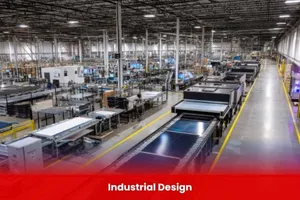Industrial Design
Burraq UK is committed to providing cutting-edge technical education and training in various engineering disciplines, including Industrial Design. This program is tailored for individuals who aim to blend creativity with engineering principles to design innovative, functional, and user-centered products and systems.Industrial Design bridges the gap between engineering, aesthetics, and usability by focusing on the entire product development cycle — from conceptual sketches to prototyping and manufacturing.

Aim of Industrial Design
The aim of the Industrial Design course at Burraq Engineering Solutions UK is to equip students and professionals with the creative, technical, and practical skills necessary to design innovative, user-friendly, and manufacturable products and systems.This program focuses on integrating aesthetic design principles with engineering knowledge to develop solutions that meet user needs, market demands, and manufacturing constraints.
Course Overview
Industrial Design
Educational Background
Applicants should have one of the following qualifications:
- Intermediate (FA/FSc) or equivalent with a strong interest in design and engineering
- Diploma (DAE) or Bachelor’s degree in related fields such as:
- Mechanical Engineering
- Product Design
- Architecture
- Industrial Engineering
- Graphic Design (with engineering/technical focus)
Skills & Knowledge (Preferred but not mandatory)
- Basic understanding of technical drawing or drafting
- Familiarity with computers and design software (e.g., AutoCAD, SolidWorks, Adobe Illustrator)
- Creative mindset and problem-solving ability
| Course Code | Curriculum Title | Credit | DLH |
|---|---|---|---|
| BUK1399-1 | Introduction to Industrial Design | 4 | 15 |
| BUK1399-2 | Technical Drawing & Sketching | 4 | 15 |
| BUK1399-3 | Computer-Aided Design (CAD) | 4 | 15 |
| BUK1399-4 | Materials and Manufacturing Processes | 4 | 15 |
| BUK1399-5 | Ergonomics and Human Factors | 4 | 15 |
| BUK1399-6 | Prototyping and Model Making | 4 | 15 |
| BUK1399-7 | Product Development and Lifecycle | 4 | 15 |
| BUK1399-8 | Design Communication and Presentation | 4 | 15 |
Learning Objectives
- Introduction to Industrial Design
- Overview of industrial design and its role in engineering
- History and evolution of product design
- Design thinking and creative problem-solving processes
- Technical Drawing & Sketching
- Manual sketching techniques
- Orthographic and isometric drawings
- Basics of technical drafting
- Computer-Aided Design (CAD)
- Introduction to CAD software (AutoCAD, SolidWorks, or similar)
- 2D drafting and 3D modeling
- Creating detailed product designs and assemblies
- Materials and Manufacturing Processes
- Properties of materials used in product design (metals, plastics, composites)
- Manufacturing techniques (injection molding, casting, machining, 3D printing)
- Design considerations for manufacturability and sustainability
- Ergonomics and Human Factors
- Human anatomy and interaction with products
- Designing for comfort, safety, and usability
- User-centered design principles
- Prototyping and Model Making
- Physical model making techniques
- Rapid prototyping and 3D printing
- Testing and iterating design prototypes
- Product Development and Lifecycle
- Concept development and ideation
- Design validation and testing
- Lifecycle analysis and sustainable design practices
- Design Communication and Presentation
- Creating technical drawings and design documentation
- Presentation techniques and portfolio development
- Use of visualization software and rendering tools
- Industry Projects and Case Studies
- Real-world design challenges
- Collaborative projects with industry focus
- Report writing and project management skills
- Students Intermediate (F.A/F.Sc or A-Levels)
- Diploma (DAE) holders
- Engineering & Design Graduates
- Working Professionals
- All Modules within this qualification are assessed internally by the approved training Centre and externally verified by BURRAQ UK. The program uses a criterion-referenced assessment approach to ensure that learners successfully meet all required learning outcomes.
- A Pass in any unit is granted only when the learner submits valid, reliable, and authentic evidence that demonstrates achievement of the assessment criteria. The Assessor is responsible for reviewing this evidence and confirming that the learner has attained the expected standard.
